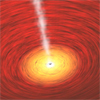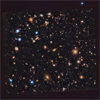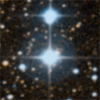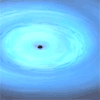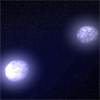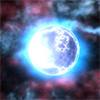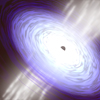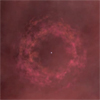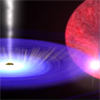CXC Home | Search | Help | Image Use Policy | Latest Images | Privacy | Accessibility | Glossary | Q&A
High-Definition Podcasts are also available. Please see the "Beautiful Universe"
1. Animation of Hidden Baby Black Hole
High Definition
[Runtime: 0.20]
View Stills
(NASA/CXC/A. Hobart)
Related Chandra Images:
High Definition
- Viewable .m4v (44.2 MB)
[Runtime: 0.20]
View Stills
(NASA/CXC/A. Hobart)
Related Chandra Images:
- Photo Album: Chandra Deep Field South
2. Multi-wavelength Views of the Chandra Deep Field South
High Definition
[Runtime: 0.27]
(X-ray: NASA/CXC/U. Hawaii/E. Treister et al; Infrared: NASA/STScI/UC Santa Cruz/G. Illingworth et al; Optical: Wide-field: Akira Fujii; Close-up: NASA/STScI/S. Beckwith et al)
Related Chandra Images:
High Definition
- Viewable .m4v (30.9 MB)
[Runtime: 0.27]
(X-ray: NASA/CXC/U. Hawaii/E. Treister et al; Infrared: NASA/STScI/UC Santa Cruz/G. Illingworth et al; Optical: Wide-field: Akira Fujii; Close-up: NASA/STScI/S. Beckwith et al)
Related Chandra Images:
- Photo Album: Chandra Deep Field South
3. The Solar System in a Whole New Light
High Definition
[Runtime: 1.31]
(Animations: NASA, ESA/Hubble/M. Kornmesser & L.L. Christensen, NASA/GFSC/G. Shirah, J. Tucciarone. Production: NASA/CXC/K.K. Arcand & A. Hobart with thanks to SPL. Music: Move Two)
High Definition
- Viewable .m4v (31.2 MB)
[Runtime: 1.31]
(Animations: NASA, ESA/Hubble/M. Kornmesser & L.L. Christensen, NASA/GFSC/G. Shirah, J. Tucciarone. Production: NASA/CXC/K.K. Arcand & A. Hobart with thanks to SPL. Music: Move Two)
4. Zoom in to Cygnus X-1
High Definition
[Runtime: 00:30]
(NASA/CXC/A. Hobart)
Related Chandra Images:
High Definition
- Viewable .m4v (85.4 MB)
[Runtime: 00:30]
(NASA/CXC/A. Hobart)
Related Chandra Images:
- Photo Album: Cygnus X-1
5. Animation of Black Hole Formation in SN 1979C
High Definition
[Runtime: 00:20]
(NASA/CXC/A.Hobart)
Related Chandra Images:
High Definition
- Viewable .m4v (9.1 MB)
[Runtime: 00:20]
(NASA/CXC/A.Hobart)
Related Chandra Images:
- Photo Album: SN 1979C
6. Animation of Merger Trigger for Supernova
High Definition
[Runtime: 0.20]
View Stills
(NASA/CXC/A.Hobart)
Related Chandra Images:
High Definition
- Viewable .m4v (8.5 MB)
[Runtime: 0.20]
View Stills
(NASA/CXC/A.Hobart)
Related Chandra Images:
- Photo Album: M31
7. 3-D Fly-Through of Cassiopeia A
High Definition
This visualization shows a fly-through of Cas A based on the 3-D representation constructed from Chandra and Spitzer data. It begins with an artists rendition of the neutron star previously detected by Chandra. Next, new features unseen in traditional 2-D data sets are visible, including details of how the parent star exploded. The green region is mostly iron observed in X-rays; the yellow region is mostly argon and silicon seen in X-rays, optical and infared; the red region is cooler debris seen in the infared and the blue region is the outer blast wave, most prominent in X-rays.
[Runtime: 0:53]
(Visualization: NASA/CXC/D.Berry; Model: NASA/CXC/MIT/T.Delaney et al.)
Related Chandra Images:
High Definition
- Viewable .m4v (23.8 MB)
- QuickTime movie (uncompressed)
- D1 (0.9 pixel aspect ratio)
- 720x486
- 29.97 fps
- file size = (1.5 GB)
This visualization shows a fly-through of Cas A based on the 3-D representation constructed from Chandra and Spitzer data. It begins with an artists rendition of the neutron star previously detected by Chandra. Next, new features unseen in traditional 2-D data sets are visible, including details of how the parent star exploded. The green region is mostly iron observed in X-rays; the yellow region is mostly argon and silicon seen in X-rays, optical and infared; the red region is cooler debris seen in the infared and the blue region is the outer blast wave, most prominent in X-rays.
[Runtime: 0:53]
(Visualization: NASA/CXC/D.Berry; Model: NASA/CXC/MIT/T.Delaney et al.)
Related Chandra Images:
- Photo Album: Cassiopeia A
8. Animation of a Blob
High Definition
[Runtime: 0.30]
(NASA/CXC/A.Hobart)
Related Chandra Images:
High Definition
- Viewable .m4v (17.2 MB)
[Runtime: 0.30]
(NASA/CXC/A.Hobart)
Related Chandra Images:
- Photo Album: Lyman Alpha Blobs
9. Animation of a Supernova Explosion
High Definition
This artist's animation shows the basics of a supernova explosion like the one that created Cas A. When a massive star runs out of fuel, it collapses onto itself and its remains are then expelled into the surrounding space. This expanding debris field is very hot and thus glows brightly in X-rays, which are detected by telescopes like Chandra. At the end of the animation, the view dissolves into an image of Cas A created from Chandra data.
[Runtime: 00:26]
(NASA/CXC/A.Hobart)
Related Chandra Images:
High Definition
- Viewable .m4v (8.4 MB)
- QuickTime movie (uncompressed)
- D1 (0.9 pixel aspect ratio)
- 720x486
- 29.97 fps
- file size = (810.9 MB)
This artist's animation shows the basics of a supernova explosion like the one that created Cas A. When a massive star runs out of fuel, it collapses onto itself and its remains are then expelled into the surrounding space. This expanding debris field is very hot and thus glows brightly in X-rays, which are detected by telescopes like Chandra. At the end of the animation, the view dissolves into an image of Cas A created from Chandra data.
[Runtime: 00:26]
(NASA/CXC/A.Hobart)
Related Chandra Images:
- Photo Album: Cassiopeia A
- Photo Album: Cassiopeia A
10. Animation of Jet and Wind around GRS 1915+105
High Definition
[Runtime: 0.25]
View Stills
(NASA/CXC/A.Hobart)
Related Chandra Images:
High Definition
- Viewable .m4v (11.1 MB)
[Runtime: 0.25]
View Stills
(NASA/CXC/A.Hobart)
Related Chandra Images:
- Photo Album: GRS 1915+105


